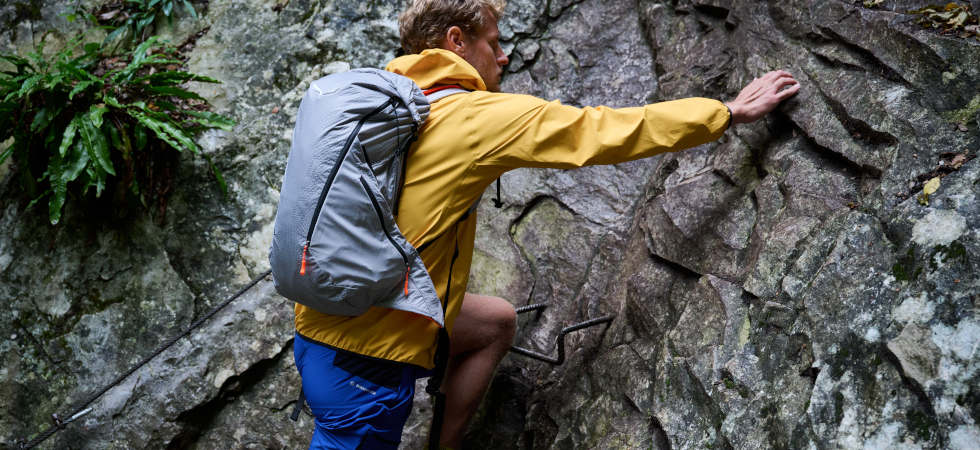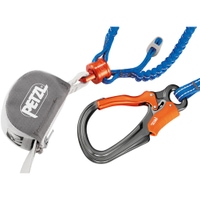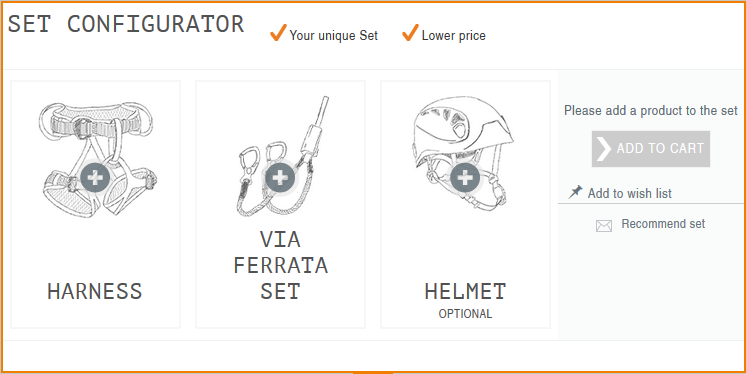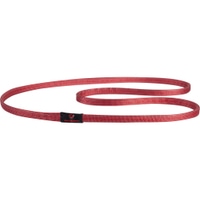Three things are essential for a via ferrata: helmet, harness and, of course, a via ferrata set. In addition, there are a few other items that should be in your backpack – we’ll show you what these are in our packing list. Each item is explained in more detail below.
VIA FERRATA: WHAT TO BRING
√ Via Ferrata Set
√ Helmet
√ Harness
√ Approach shoes (climbing boots)
√ Comfortable, sturdy clothing
√ Light, compact backpack
√ Rain jacket
√ Sunscreen
√ First aid kit
√ Bivouac sack
√ Headlamp
√ Mobile phone
√ Food and drink
√ Passport and DAV card
Via Ferrata: Optional equipment
√ Sling with carabiner for resting in between
√ Via ferrata gloves
√ Short single rope and belay device (for belaying children or beginners)
√ Change of clothing
√ Warm jacket

EQUIPMENT DETAILS FOR YOUR VIA FERRATA
Here we explain in more detail what to look out for when buying your first via ferrata kit.
The via ferrata set
The via ferrata set is an essential part for climbing a via ferrata. It is attached to the harness with a loop. There are two Y-shaped load arms at the front and a special via ferrata carabiner at the end of each. These carabiners are used to attach yourself to the steel wires of the via ferrata. Caution: Both carabiners must be clipped in at all times, and one must always remain hooked in during clipping onto the next belay wire.
So everything safe? It depends: Even though you are secured, it is important to avoid falling when climbing a via ferrata, as serious injuries can occur. If you do fall, the integrated fall absorber (the “package” between the loop and the load arms) will soften your fall and reduce the forces acting on you. However, due to the nature of the terrain and the potential height of the fall, you are not immune to injury. The main purpose of the via ferrata kit is to protect you from a total downfall.
There are different types of carabiner, so you may need to test which system suits you best before you buy. Some via ferrata sets also have swivel joints so that your load arms don’t get tangled all the time.

Via ferrata sets are usually designed for people weighing between 40 and 120 kilos. This is the only weight range where the device can provide reliable protection. So be careful with children – there are a few sets with a weight range of 30 to 80 kilos. These may also be suitable for lighter adults.
We have a set configurator that makes it easy for you to put together a complete via ferrata set. You can choose a via ferrata set, helmet and harness and pay a lower price than if you bought everything separately.
The harness for via ferratas
There are special harnesses for via ferrata climbing that have minimal padding. Since you are moving all the time and only resting a little in the harness, you should pay attention to weight and freedom of movement. Above all, you should feel comfortable in your harness.
For children, a full-body harness is recommended. They guarantee extra stability.
Non-negotiable: the helmet
You can buy a climbing helmet for the via ferrata. It is very important that it fits well and is comfortable. There are two types of helmet: the hard shell helmet, which is very strong and durable, and the soft shell helmet, which is lighter but more delicate. Both provide good protection.

Sling – for a quick rest on the via ferrata
Optionally, you can carry a webbing sling with a screw or HMS carabiner. This allows you to sit in the harness and relax without putting too much strain on the via ferrata set or hanging too far from the steel rope.
Appropriate footwear
Approach shoes are suitable for most via ferrata routes. Many have a “climbing zone” (a friction surface on the front) and can be laced for a better fit. They are usually rubber-lined and have a medium-hard sole. If you are doing really difficult and demanding via ferratas, you can also pack your climbing shoes.
The right clothing
We recommend that you wear flexible and robust clothing, ideally in two layers. Although you may start to sweat on the way up, you don’t want to cool down or freeze on the way down.
Depending on the weather (forecast) you can wear shorts – but long trousers will protect you better from scratches and sharp rock. Merino wool tops will keep you warm but cool you down if you start to sweat – and they dry quickly.
As the weather can change at any time in the mountains, it is a good idea to have a light raincoat in your pack, just in case, and perhaps a warm layer to wear if necessary. It doesn’t hurt to have a change of clothes with you so you can change for the way down.
Via ferrata gloves
There are special via ferrata gloves that are recommended if you have sensitive hands, especially if you are planning to do a long via ferrata. Otherwise, the iron can become quite painful over time.
Backpack – light and compact
A light and small climbing backpack can be very useful. Make sure there are not too many straps and loops on the outside, otherwise you could get caught. Try to avoid attaching your bottle or jacket to the outside, as this can also hinder you.

Snacks and drinks
Don’t forget to pack enough water. Especially on long trips, it’s important that you don’t become dehydrated. Of course, it’s always a good idea to carry some kind of a fruit or candy bar. And maybe you’d like to take a little chocolate as a reward for reaching the summit.
Don’t forget: Emergency equipment
First aid kit
It may only be a scratch, but on a via ferrata you’ll be grateful for a band-aid. A first-aid kit with a rescue blanket should be in every backpack.
Headlamp
A headlamp is part of every moutain tour and should always be in your backpack.
Mobile phone
For safety reasons, it is a good idea to have a mobile phone with you. If you are unsure, check beforehand whether you will have reception on your chosen route.
Bivy bag
To set up an emergency bivouac in risky or unexpected situations.
Now, if the weather forecast is in your favor, there is nothing else in your way to the top. Enjoy, and be careful out there!
Are you interested in other related articles about climbing? We have some more for you:
→ The most popular types of climbing at a glance


























